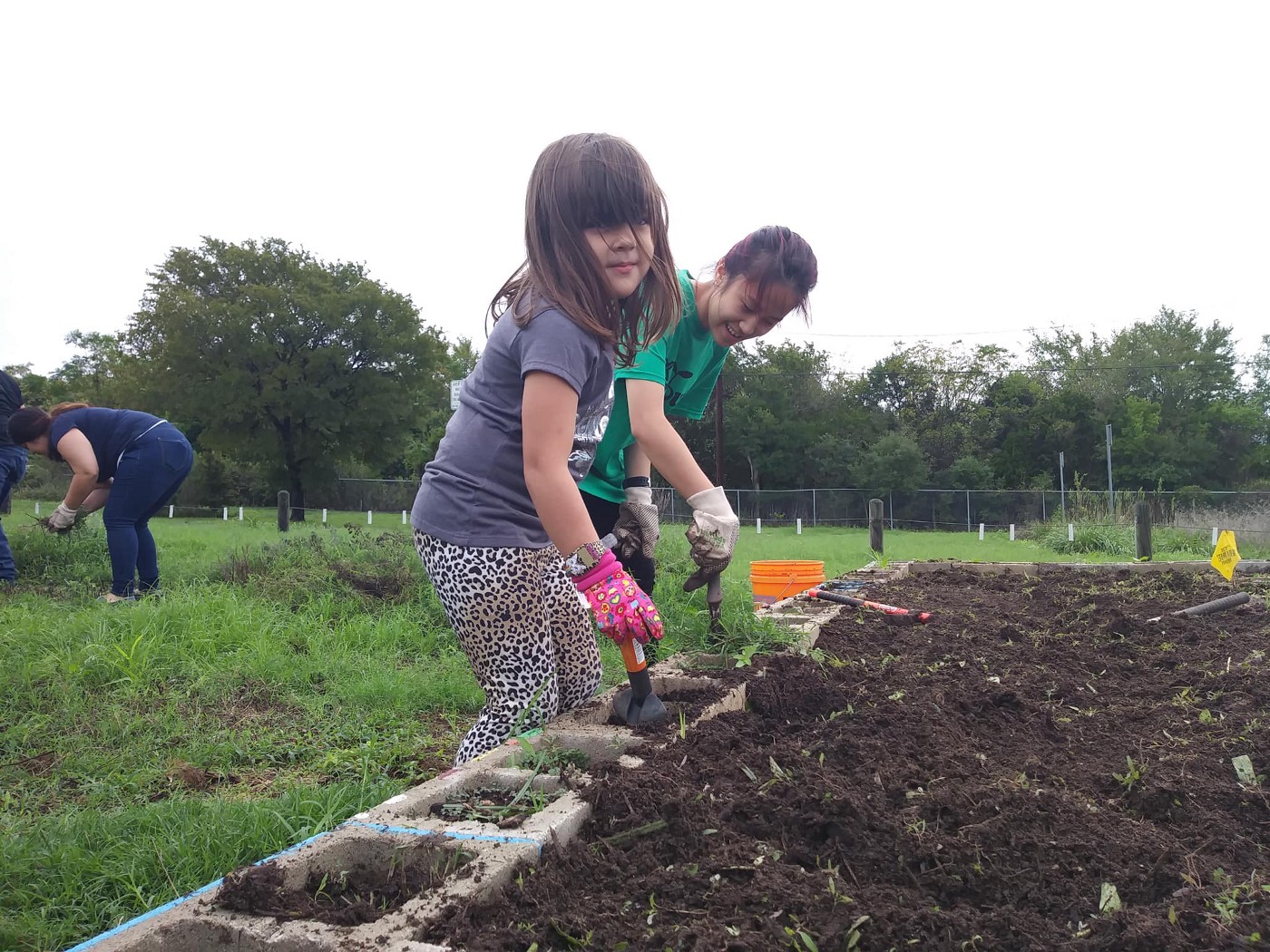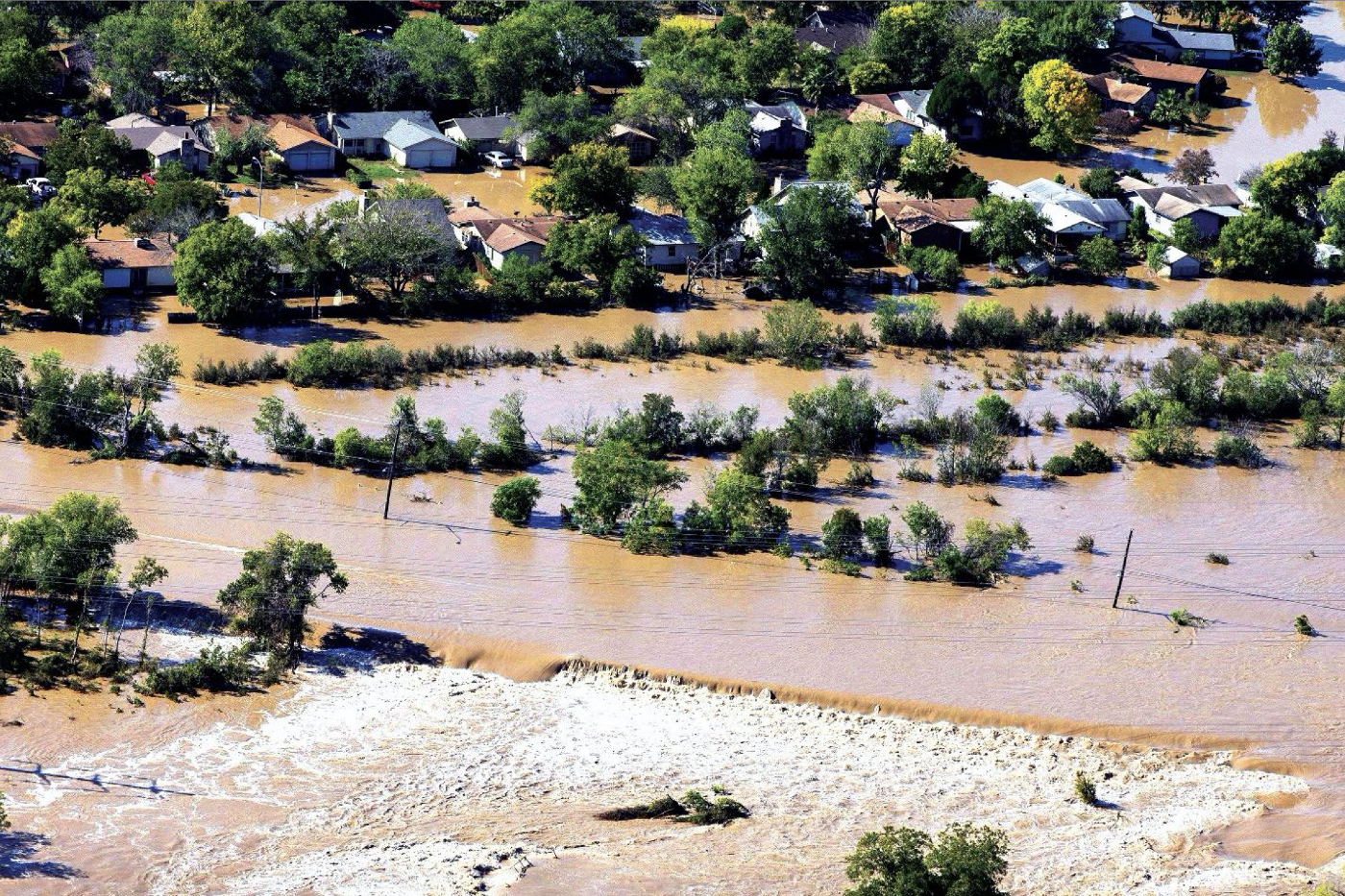
Frances Acuña has lived in the Dove Springs neighborhood in Southeast Austin for 23 years. She knows every place it floods when it rains — such as the intersection at Brassiewood Drive and Pleasant Valley Road, in the street along Turnstone Drive, and near the Nuckols Crossing Bridge that spans Williamson Creek.
The flooding is so bad, Acuña and her neighbors have had to put out bags of cement as barriers to keep the water from reaching into homes when it rains. They’ve barricaded roads to prevent cars from driving down streets, afraid they would push the rising water closer to their doorsteps. Some neighbors have even gone so far as to physically remove trash and debris that clogs the drainage pipes, scraping on their hands and knees in the pouring rain to keep the water flowing to the nearby detention pond.
Acuña says the flooding has gotten worse over the years as the city’s population has increased, leading to more development in the region. Added streets, sidewalks, and buildings has meant more impervious cover — and that means materials like concrete and asphalt that can’t absorb water when it rains, leading to runoff. This, combined with the effects of climate change, has led to devastation in the area she calls home.
“Now, it’s been just about every year that our homes get flooded,” Acuña says.
Acuña will soon be one of several people who live in Dove Springs to collaborate in a first-of-its-kind study by The University of Texas at Austin that will combine the high-quality weather, pollution, and traffic data that researchers are used to collecting with new sources of information, including residents’ lived experience, to make the area more resilient in the face of climate change.
Lived experience includes the day-to-day knowledge residents have about a place, like where it floods when it rains or areas that get extremely hot in heat waves — the kinds of things Acuña knows about firsthand as a Dove Springs resident.
“They are the ones with the knowledge and science. But we have the life experiences in our neighborhood. We are the ones who feel the force of the water.”
The project, a collaboration among neighborhood residents, UT, the City of Austin, the community organization Go! Austin/Vamos! Austin, and St. Edward’s University, will creatively examine long-standing problems in neighborhoods like Dove Springs, which tend to have worse outcomes in response to climate-related issues because of inadequate infrastructure and investment. The work is generously supported by a National Science Foundation (NSF) grant.
Climate issues aren’t created equal
Researchers say gathering residents’ personal experiences is important because it will help fill the gaps that currently keep city officials from making effective changes.
For example, engineering maps can tell a lot about where it floods, explains Marc Coudert, environmental program manager with the City of Austin’s Office of Sustainability. But they don’t show everything. Engineering maps do not show what happens if trash and debris clog the drainage pipes in a neighborhood like Acuna’s or, moreover, how people are personally impacted by flooding.
“Floodplains are really, really important,” Coudert says. “But they can’t be the only form of data we use to determine need. They don’t take into account income, vulnerability, and other factors.”

Talking to people about their personal experiences will help account for these other variables, instead of simply relying on numerical data and maps.
And it’s something researchers admit often neglecting in their work. Collecting and studying people’s lived experiences requires building trust and relationships within a community, and that’s time consuming. Moreover, personally observed evidence hasn’t carried the same weight as hard data within most scientific circles — but it could be the key to solving some long-standing climate issues.
“They are the ones with the knowledge and science,” Acuña says of UT. “But we have the life experiences in our neighborhood. We are the ones who feel the force of the water.”
Making data work for residents
To gather the lived experience of residents, researchers will train what they are calling “climate navigators” in Dove Springs — between 20 and 40 people who live in the neighborhood who will work on the project.
They will be paid with portions of the NSF grant money and will go on to train their neighbors how to anticipate, prepare for, and respond to climate stressors — particularly flooding.
Their primary role will be to help researchers build a giant data portal by using iPads to upload their personal narratives, photos, videos, and sound recordings of things like flooding, traffic hazards, and other problems in the neighborhood. Katherine Lieberknecht, an assistant professor in UT’s School of Architecture who is leading the project, says the portal will be like a giant, visual and interactive 311 repository where residents can place their concerns.
“In a way, it’s rethinking how we do city processes and city programs. This portal is an opportunity to lay things out in a way that’s understandable to everyone — engineers and planners across our departments. Sometimes you just need to have the same vocabulary to get to a spot where you can make decisions.”
Researchers will then take this personal experience (what’s known as qualitative or descriptive data) and find a way to analyze and transform it into statistical, mathematical, and computational information (quantitative data) that can help the city design solutions.
For example, if residents upload several photos of the neighborhood detention pond filling with water, researchers could use machine learning to show how fast the water would rise in a future storm. This new kind of data product could help the city decide where to make stormwater improvements by showing them information they often miss in outdated flood maps that don’t account for localized flooding.
“If residents have concerns, this is a place for those concerns to go, and there’s a record of them,” Lieberknecht says. “Then, we know they have been made and the city is aware of them. In a way, it should increase accountability and transparency on the city’s part as well.”
Researchers hope the information will lead to better design choices, like where to plant shade trees in the neighborhood to reduce the urban heat effect or determining the safest ways in and out of the neighborhood when it’s flooding.
“In a way, it’s rethinking how we do city processes and city programs,” Coudert explains. “This portal is an opportunity to lay things out in a way that’s understandable to everyone — engineers and planners across our departments. Sometimes you just need to have the same vocabulary to get to a spot where you can make decisions. That’s where the portal comes in, to show people in a visual way these are the issues, here is what we aren’t talking about, and here are the ways we should be talking about it to move forward.”
The final plan for the data portal is still being developed. However, researchers say it will be key to work with community members to find out what information they want to know about and solve.
“They understand their own problems most intimately. Therefore, they have to be a key part in shaping the solutions,” says Carmen Llanes Pulido, executive director for GAVA, which advocates for equal access to healthy living in Austin’s Eastern Crescent, including Dove Springs. “Otherwise, we risk putting a bunch of resources into interventions that don’t actually address the root cause or the problems we need to solve.”
Researchers will rely on the computing power of the Texas Advanced Computing Center to build the data portal. UT researchers from Cockrell School of Engineering, LBJ School of Public Affairs, Moody College of Communications also are part of the project. And information technology experts and researchers from Dell Medical School, who have experience with data privacy, will be working to make sure the information in the portal is secure.
“It’s a very collaborative team,” Lieberknecht says. “We are really trying to meld communications, planning, engineering, and computer sciences, in addition to the more specific pieces like data privacy and community engagement.”
The project is supported by Planet Texas 2050, a grand challenge research initiative at UT that is working to make Texas more resilient in the face of population growth and climate change.
A model for the future
Researchers chose the Dove Springs neighborhood because it has seen increased flooding over the years given its location near Onion Creek and new development that has worsened runoff. The neighborhood, too, has long been neglected, with unequal investments in stormwater infrastructure. Its population is lower-income and therefore, in some ways, less prepared to deal with the fallout from climate-related catastrophes like flooding.
“Although many places across Austin and Texas are already experiencing the impacts of climate change, Dove Springs’ has been severe and ongoing,” Lieberknecht says. “But they’ve also had tremendous success working as a community to advocate for themselves and to demand more equitable climate planning from the city. And I think that has had a real effect.”

While Dove Springs is the starting point, the project will be able to be replicated for other areas and will hopefully serve as a model for future climate planning.
Another huge component of the study will be to measure what resiliency actually looks like to residents, to gauge — from people in the neighborhood — if the city is actually moving the needle on important issues. And Coudert assures residents that the city would not wait until the portal is complete to launch critical, climate-related projects. As they have conversations with residents, those conversations will help inform interventions that are currently underway.
For Acuña, what she says she wants most is to be able to sleep peacefully at night when it rains, without fear of flooding.
“I think UT has a good plan,” she says. “They are going by residents’ narratives to meet that gap between experience and knowledge in order to work together and build the right strategies and preparedness plan to be the most effective.”
“I have faith because it’s not for power and it’s not for self-gain,” she adds. “It’s for empathy and love for our community — for the right reasons.”

